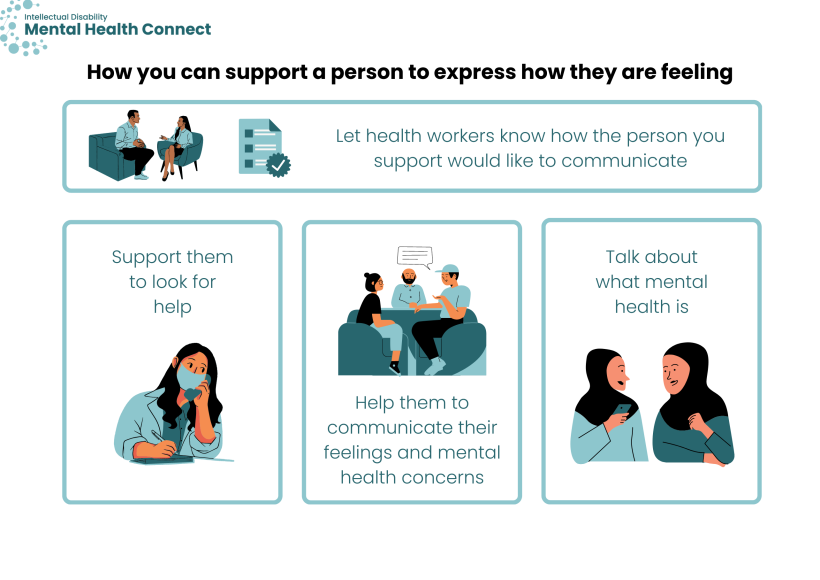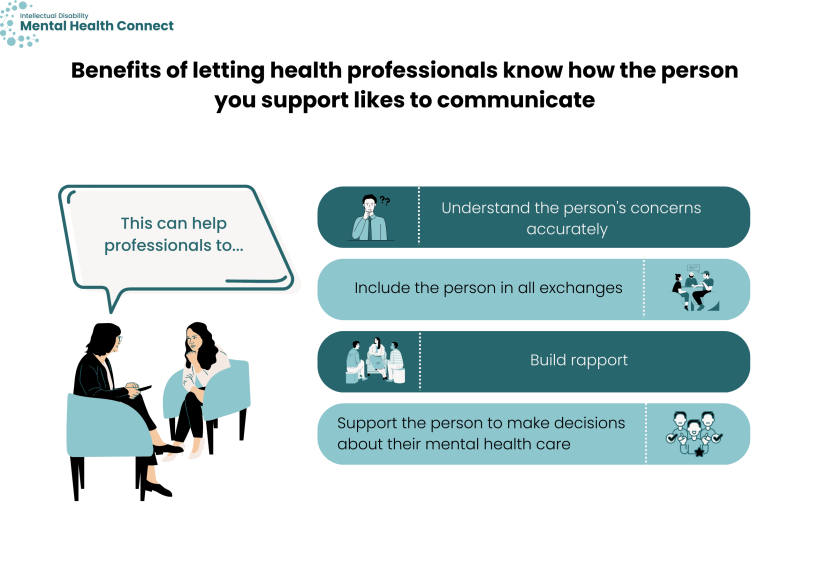Jump to a section below
Importance of communicating feelings and mental health concerns
Sharing our feelings and mental health concerns can be an important step to feeling better. The person with intellectual disability you support may want to share their feelings and concerns with you. They may want you to:
- listen
- help work out what made them feel a certain way
- understand what help they may need
- support them to make a plan to feel good again.
Some people do not know why they feel different and may not be able to express how they are feeling.
The person may feel confused and worried. You can support them by:
- helping them to communicate their feelings and mental health concerns
- talking about what mental health is
- supporting them to seek help
- letting health professionals know how the person you support would like to communicate.

Ideas for supporting the person to communicate their feelings and mental health concerns
An important first step to communicating feelings is to recognise and label those feelings in day-to-day life.
You can encourage the person to share their feelings by:
- asking how things are going for them lately e.g. are they happy where they are living, with their job, family, and friendships?
- letting the person know that they can speak to you about any worries they have
- being respectful of how they feel, and why they may feel that way
- modelling direct and honest language.
You can model direct and honest language by sharing:
- how you feel
- when you feel this way
- why you feel this way
- what you want to change.
You can also help the person by teaching them about mental health. You can use the information in About mental health and ID or Easy Read documents such as:
- 3DN’s Getting help with your mental health Easy Read information sheet
- Council for Intellectual Disability’s Mental Health guide
Letting health professionals know how the person you support likes to communicate
It is important that health professionals are aware of how the person you support likes to communicate.
This can help professionals to adapt their practice and:
- include the person in all exchanges
- build rapport
- understand the person's concerns accurately
- support the person to make decisions about their mental health care.

You can encourage the person that you support to communicate about their preferences.
If they need help you could ask if it is OK for you to share information about their communication preferences with the health professional.
You could also help the health professionals learn about the person’s communication preferences by:
- modelling the communication preferences of the person
- sharing resources about the person’s preferred communication method. You can see below for examples.
Important information to tell health professionals about the person’s communication
When the person you support starts working with a health professional it is important that they know about:
- the communication preferences of the individual e.g. explain the specific communication tool(s) the person might use
- how the person likes to read written information e.g. in Easy Read or plain English
- if the person usually uses a communication interpreter.
Modelling communication preferences of the person
You will likely have knowledge of how best to share information and ask questions in a way that the person you support understands. With the person’s permission you can:
- model, or show, health professionals how best to communicate with the person you support e.g. how you ask questions, use any communication tools, and explain complex concepts.
- help the health professionals understand what the person is communicating e.g. if they use particular words to describe a feeling or object, or how to interpret what they express via communication tools.
Sharing resources
The person you support may use different communication tools to help them share information and need additional supports to understand information.
You can help health professionals understand these tools and methods to improve their communication by sharing resources.
Below are some communication tools you could use to support communication. You may want to share information and resources about the following tools, guides and activities. However, the health professional should try to use tools that the person already uses.
Communication Tools for sharing mental health information
Feelings thermometer
A feelings thermometer can help the person you support recognise how they feel. Each colour on the thermometer represents a different feeling. You can support the individual to recognise their feelings by commenting on the corresponding colours on the thermometer.
The Council of Intellectual Disability has an example of a feelings thermometer on page 30 of their My Health Matters Folder.
Feelings diary
The person you support can write about or draw their thoughts and feelings in their feelings diary. Their diary might be on paper, their phone or their computer. People could write or draw about:
- something that happened
- how it made them feel
- how strong the feeling was
- how their body felt while experiencing that feeling
- what they said at the time.
The person you support may not want to share their feelings diary with others; that is OK.
Talking Mats use symbols and images to support people in communicating their opinions and reflecting and making choices from options. They can be used to support discussions about a person’s care.
Other communication tools
Key Word Sign is the use of manual signs and natural gestures to support communication. Key Word Sign Australia provides resources to families, support persons and professionals.
Speakbook is a communication tool for people who cannot speak or use their hands. With Speakbook, individuals can communicate using only their eyes.
The Hospital Communication Book
This Hospital Communication Book contains information about why people may have difficulties understanding or communicating, tips to help improve communication, and pages of pictures you can use to assist communication.
The Picture Communication Tool comprises sets of drawings that can be used with people who use less verbal communication. The illustrations are free to download and are ready for printing.
Communication passport
A communication passport outlines the preferred communication style of the person you support. The passport combines information from several people, and from multiple contexts in the past and the present. A communication passport can be helpful for health professionals who have recently started working with the person, helping them obtain key information. Below are some examples of communication passport templates:
- My Communication Passport
- The Council for Intellectual Disability’s My Health Matters folder has a section for outlining a person’s communication style.
FaceSay is a Social Skills Software program that teaches skills necessary to recognise changes in facial expressions related to emotions through games. These skills can then be used in other environments. FaceSay was originally created for a younger audience. However, it may still be helpful for the person you support and should be considered individually.
Guides
Your guide to Communicating with people with profound and multiple learning disabilities
Produced by Mencap in the United Kingdom, these guides are designed to provide an introduction to communication and the problems faced by someone with an intellectual disability. The guides also contain tips on how to be a better communicator.
Social stories and comic strip conversations
Produced by the National Autistic Society in the United Kingdom, these guides provide an introduction to social stories and comic strip conversations. Social stories and comic strip conversations can help people with intellectual disability to develop a greater social understanding of emotions. They are short descriptions of a particular situation, event or activity, with specific personalised information about what to expect in that situation and why.
You can also find more information about making information accessible in the Communication section for professionals and in 3DN’s Making mental health information accessible for people with intellectual disability – A Toolkit.
